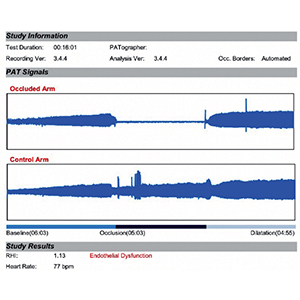Endothelial dysfunction in COVID-19 patients assessed with Endo-PAT2000

All claims expressed in this article are solely those of the authors and do not necessarily represent those of their affiliated organizations, or those of the publisher, the editors and the reviewers. Any product that may be evaluated in this article or claim that may be made by its manufacturer is not guaranteed or endorsed by the publisher.
Authors
It has been widely reported that the Severe Acute Respiratory Syndrome Coronavirus 2 (SARS-CoV-2) attaches human cells by using the Angiotensin Converting Enzyme 2 (ACE2) receptor, but vascular impairment described during coronavirus disease 2019 (COVID-19) infection is primarily due to the direct involvement of the endothelial cells by the virus or secondarily to the inflammatory host response is currently unknown. We therefore aimed to demonstrate in vivo the presence of endothelial dysfunction in six COVID-19 patients without cardiovascular risk factors or pre-existing cardiac condition, using the Endo-PAT 2000, a device able to measure endothelial vasodilation function in a rapid and non-invasive way. Four patients were positive for endothelial dysfunction, with RHI values between 1.13-1.56 (average value 1.32, normal values >1.67); in one of the two negative patients the reported RHI value was slightly above the cutoff (1.72). Our findings confirm that COVID-19 patients are at higher risk of developing endothelial dysfunction. In addition, our results demonstrate that endothelial impairment may occur even in the absence of cardiovascular risk factors.
How to Cite

This work is licensed under a Creative Commons Attribution-NonCommercial 4.0 International License.






